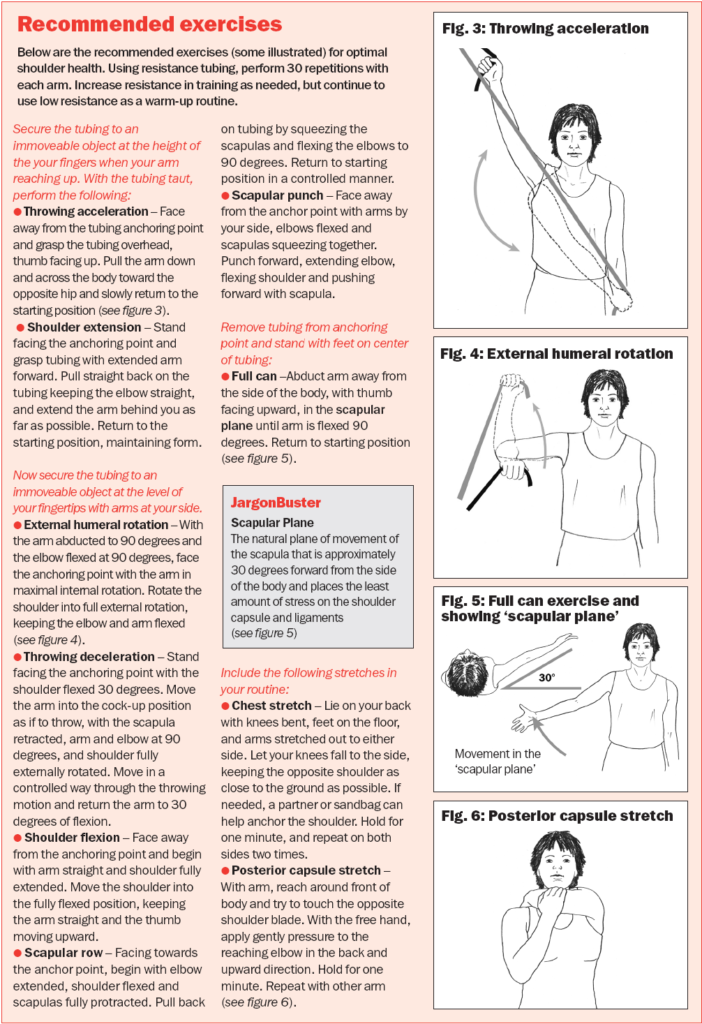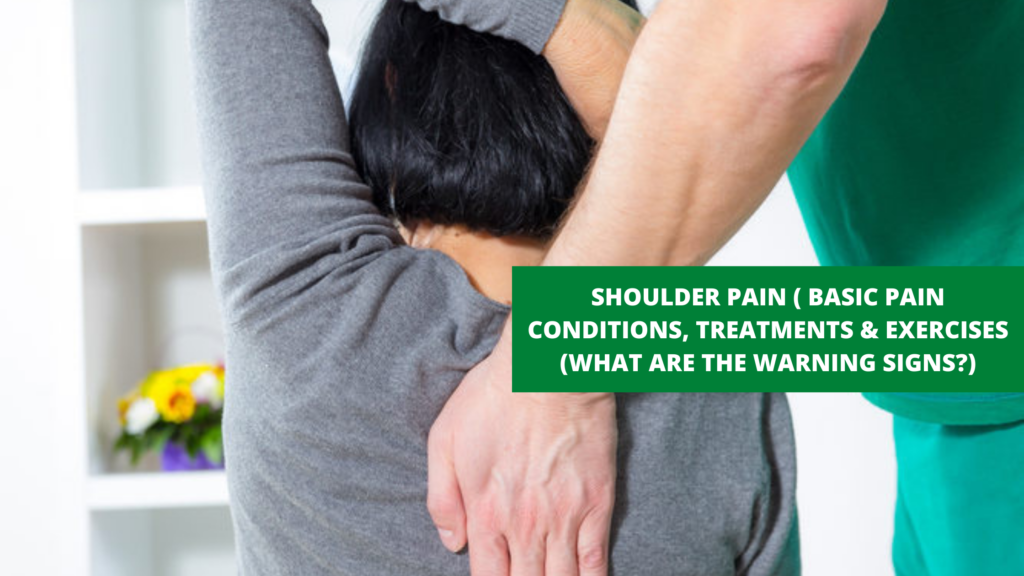After back pain this is the most common type of injury that I see on a day to day basis. ( SHOULDER PAIN)
At one time or another we all have experience shoulder pain. Sometimes we are all over-the-place and confuse on what to do and not do do!
I believe the best thing we can do – is to recognize the early signs, try out basic treatments and step up to seek professional treatment when it’s needed.
I wanted to write something that will give you an insight about the basic treatment, pain conditions and what are the WARNING SIGNS?
What causes shoulder pain?
The shoulder is a ball and socket joint with a large range of movement. Joints like these tend to be more liable to injury. Shoulder pain can result from one or more of these causes:
- Strains from overexertion
- Tendonitis from overuse
- Dislocations
- Fractures of the collar bone or upper arm bone
- Frozen shoulders
- Pinch nerves
Neck and Shoulder Pains Diagnosed?
- X-rays: Plain X-rays can show narrowing of the gap between two bones in the spine, arthritis-type diseases, tumors, slipped discs, narrowing of the spinal canal, fractures and instability of the spine
- MRI: Magnetic resonance imaging is a procedure that does not involve cutting into the body that can show the detail of elements of the nervous system.
- Myelography/CT scanning: Is sometimes used as an alternative to MRI
- Electrodiagnostic studies: Electromyography (EMG) and nerve conduction velocity (NCV) are sometimes used to diagnose arm pain, neck and shoulder pain, tingling and numbness.
Basic treatments ( Not all the treatments listed here are appropriate for every condition, but one may be helpful in your situation.)
- Application of Ice and Heat
Ice packs and heat packs are two of the most commonly used treatments for shoulder pain. So which one would be the correct one to use, ice or heat? And for how long should ice or heat treatment last? Read on for further information about these treatments.
- Take OTC pain relievers.
Such as ibuprofen or acetaminophen.
- Take a few days off from sports
Activities that aggravate your symptoms, and heavy lifting.
- Rest
The primary treatment for many common conditions that cause shoulder pain is to rest the joint, and allow the acute inflammation to die down. It is important, however, to be careful when resting the joint, because lengthy lack of movement can bring about a frozen shoulder.
COMMON SHOULDER PAIN CONDITIONS
It is vital to make an accurate diagnosis of the cause of your symptoms so that appropriate treatment can be applied. If you have shoulder pain, some common causes will be:
Bursitis | Rotator Cuff TendonitisThe commonest diagnosis for patients with shoulder pain is bursitis or tendonitis of the rotator cuff.
Rotator Cuff TearRotator cuff tears happen when the tendons of the rotator cuff separate from the bone. Surgery is sometimes required for this.
Frozen ShoulderThis is also called ‘adhesive capsulitis; this is a common problem that leads to joint stiffness. Physical therapy and stretching are very important aspects of treatment.
Calcific TendonitisCalcific tendonitis is where there are calcium deposits inside a tendon – most commonly inside the rotator cuff tendons. Treatment depends on the extent of symptoms.
Shoulder InstabilityInstability is a problem involving a loose joint. It can be caused by a traumatic injury (dislocation), or may be a developed condition over time.
Shoulder DislocationA dislocation is an injury where the top of the arm bone becomes disconnected from the scapula.Shoulder SeparationAlso called an AC separation; these injuries result from a disruption of the acromioclavicular joint. This is a different injury from a dislocation.
Labral Tear
There are several types of torn labrums and the treatment depends on the specific injury.
SLAP Lesion
The SLAP lesion is also a kind of labral tear. The commonest cause is a fall onto an outstretched hand.
Arthritis
Shoulder arthritis is not as common as knee and hip arthritis, but when it is severe it may need joint replacement.
Biceps Tendon RuptureA proximal biceps tendon rupture is when the biceps muscle tendon ruptures near the joint.
WARNING SIGNS (Seek medical attention)
When you are not sure about the cause of your shoulder pain, or if you don’t know the specific treatment required for your condition, you should get medical attention. Treatment of these conditions needs to be aimed at the specific cause of your problem.
- Unable to carry objects or use your arm
- Any injury that deforms the joint
- Shoulder pain that comes on at night or when resting
- Shoulder pain that lasts more than a few days
- Unable to raise your arm
- Swelling or serious bruising around the joint or arm
- Signs of infection, like fever, redness, or warmth
- Any other unusual symptoms
SHOULDER PAIN EXERCISE

When To Exercise Your Shoulder:
Shoulder exercises are useful in treating many of the common causes of shoulder pain. Shoulder exercises also are part of the typical rehabilitation from almost any shoulder surgery.
Shoulder exercises need to be done under the guidance of a physician to make sure that the right muscles are being targeted for your problem. If surgery has been done it is also important to only perform exercises that will not unduly stress surgical repairs in the shoulder.
Why Shoulder Exercises Should Be Done:
Shoulder rehabilitation focuses on the two most important aspects of shoulder motion: flexibility and strength. Without an adequate range of motion, many everyday tasks cannot be performed. Patients typically have shoulder stiffness when having difficulty reaching behind the back, buckling seat belts, or combing their hair.
The second most important aspect of shoulder exercises is strengthening the muscles around the shoulder. It is important not to stress the rotator cuff muscles of the shoulder. These muscles may be liable to injury and inflammation if incorrect exercises and activities are performed.
Bring your symptomatic arm across the front of your chest.
Place your other hand above the elbow and apply a gentle pressure, pulling your arm towards your chest.
Hold this position whilst you feel the stretch across the top and back of the shoulder.

Stretching A Stiff Shoulder:Stretching is not only a key part of preparing for exercise programs, but in many instances of shoulder pain, stretches are by far the most important part of treatment. Shoulder conditions frequently involve shoulder stiffness. Stretching exercises help to loosen those muscles surrounding the shoulder joint.
The commonest cause of stiff shoulders is adhesive capsulitis, popularly termed a frozen shoulder. This condition can come on independently, or as a result of immobilization after shoulder injuries or shoulder surgery. Shoulder stretches are crucial for treatment and avoidance of a frozen shoulder.
ICE & HEAT TREATMENT
Ice packs and heat pads are two of the commonest used treatments in orthopedics. So, which one will be the right one to use for your injury, ice or heat? And for how long should they last? Read on for more information about the treatment of injuries with ice packs and heating pads.
Ice Treatment
- Ice treatment is most often used for acute injuries. If you have had a recent injury (within the last 48 hours), where there is swelling, you should be use ice treatment. Ice packs can help reduce swelling around the injury.
- Ice packs are often used after injuries like ankle sprains. Applying ice packs early and often for the first 48 hours will help to reduce swelling. Lessening swelling around injuries will help to control the pain.
- Ice treatments also may be used in chronic conditions, such as overuse injuries in athletes. In these cases, ice the injured areas after activity to help control inflammation. Never apply ice to chronic injuries before activity.
Heat Treatment
- Heat treatments are used for chronic conditions to help to relax and loosen tissues and stimulate blood flow to the area. Use heat treatments for chronic conditions, such as overuse injuries, before taking part in activities.
- Don’t use heat treatments after the activity, and don’t use heat after an acute injury. Heating tissues can be performed using a heating pad, or even a hot, wet towel. When using heat treatments, be careful to use only moderate heat for a limited time to avoid burns. Never leave heating pads or towels on for long periods of time, or while asleep.
Ice or Heat?
| Ice or Heat? | ||
| Ice | Heat | |
| When To Use | Use ice after an acute injury, such as an ankle sprain, or after activities that irritate a chronic injury, such as shin splints. | Use heat before activities that irritate chronic injuries such as muscle strains. Heat can help loosen tissues and relax injured areas. |
| How To Do It | Read through the information on how to ice an injury. There are several ways to ice an injury. | Heating pads or hot wet towels are both excellent methods. Place a washcloth under hot tap water and then apply to the injured area. |
| For How Long | Apply ice treatments for no longer than 20 minutes at a time. Too much ice can do harm, even cause frostbite; more ice application does not mean more relief. | It is not necessary to apply a heat treatment for more than about 20 minutes at a time.Never apply heat while sleeping |
Again this article is designed to give you guidelines.
Immediately seek medical professional attention if there has been no improvement.
In most cases this type of pain is muscular which can be easily treated with Physiotherapy or Acupuncture in two to three sessions, more complicated neck and shoulder injuries can take a little longer to resolve especially if caused by trauma with force,i.e. road traffic accident, sports injury or a serious fall,another common shoulder problem is frozen shoulder this dehabalating condition responds very well to a combination of physical therapy and acupuncture.
If you have any enquiry and need help to be on the right path of treatment- I would love to hear from you!
P.S I’m on a mission to be the best physical therapist and acupuncturist to my community!


